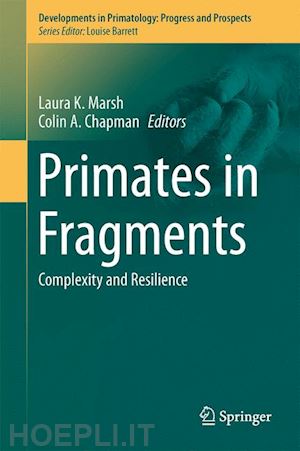Section I: Introduction.- 1. Because Conservation Counts: Primates and Fragmentation.- 2. Assessing Habitat Fragmentation Effects for Primates: The Importance of Evaluating Questions at the Correct Scale.- Section II: Long-term and Regional Studies.- 3. One Hundred Years of Solitude: Effects of Long-Term Forest Fragmentation on the Primate Community of Java, Indonesia.- 4. A Region-Wide Review of Mesoamerican Primates: Prioritizing for Conservation.- 5. Primates of the Biological Dynamics of Forest Fragments Project: A History.- 6. Lessons From Los Tuxtlas: 30 Years of Research Into Primates in Fragments.- 7. Going, Going, Gone: A 15-year History of the Decline of Primates in Forest Fragments Near National Park, Uganda.- Section III: Landscape, Metapopulations, and the Matrix.- 8. Primate Populations in Fragmented Tropical Dry Forest Landscapes in Southwestern Nicaragua.- 9. Living on the Edge: Habitat Fragmentation at the Interface of the Semi-Arid Zone of the Brazilian Northeast.- 10. Do Patch Size and Dispersal Distance Influence the Distribution of Brown Howler Monkeys (Alouatta guariba clamitans) in a Fragmented Landscape in South Brazil?.- 11. Status Monitoring of Isolated Populations of Macaques and Other Non-Human Primates in Thailand.- 12. An Eight-Year Life History of a Primate Community in Fragments in Colombian Llanos.- 13. A Critically-Endangered Capuchin (Sapajus apella margaritae) Living in Mountain Forest Fragments on Isla de Margarita, Venezuela. Section IV: Feeding and Behavioral Ecology.- 14. “Specialist” Primates Can Be Flexible In Response To Habitat Alteration.- 15. Fragments and Food: Red-tailed Monkey Abundance in Privately Owned Forest Fragments of Central Uganda.- 16. Fragment-Adaptive Behavioral Strategies and Intersite Variation in the Ring-Tailed Lemurs of South-Central Madagascar.- 17. The Simplified Novel Diet of the Blond Capuchin in the Vanishing Pernambuco Endemism Centre.- 18. Effects of Habitat Alteration on RestingBehaviour of the Sahamalza Sportive Lemur in Northwest Madagascar.- Section V: Endemic, Endangered, and Nocturnal Primates.- 19. Multi-Level and Multi-Disciplinary Approaches to Understanding Endangered Primates in Complex Landscapes: Golden-headed Lion Tamarins in Southern Bahia, Brazil.- 20. A Critically-Endangered Capuchin Monkey (Sapajus xanthosternos) Living in a Highly-Fragmented Hotspot.- 21. Coping with Fragmented Forests: The Critically Endangered Tonkin Snub-Nosed Monkeys (Rhinopithecus avunculus) in Vietnam.- 22. Fragmented Primates of Nepal.- 23. The Challenges of Survival in a Concrete Jungle: Conservation of the Pied Tamarin in the Urban Landscape of Manaus, Brazil.- 24. Where Are They? Quantification, Distribution, and Microhabitat Use of Fragments by the Red Slender Loris in Sri Lanka.- Section VI: Genetics, Disease, and Parasites.- 25. Molecular Genetic Tools for Evaluating the Consequences of Habitat Fragmentation.- 26. Kinship and Dispersal Patterns in Alouatta caraya Inhabiting Continuous and Fragmented Habitats of Argentina.- 27. The Mona Monkeys of Grenada, São Tomé and Príncipe: Long-term Persistence of a Guenon in Permanent Fragments and Implications for the Survival of Forest Primates in Protected Areas.- 28. Landscape Attributes Affecting the Natural Hybridization of Mexican Howler Monkeys.- 29. Preliminary Evaluation of the Effects of Habitat Fragmentation on Habitat Use and Genetic Diversity of Pygmy Marmosets in Ecuador.- 30. Interacting Roles of Diet, Cortisol Levels, and Parasites in Determining Population Density of Belizean Howler Monkeys in a Hurricane Damaged Forest Fragment.- Section VII: Conservation and Ecology: Threats and Management.- 31. Fragmentation and Its Significance on Proboscis Monkey (Nasalis larvatus) Conservation in the Lower Kinabatangan, Sabah (North Borneo).- 32. Potential Distribution of Primates in the Yucatan Peninsula, Mexico Under Current and Climate Change Scenarios.- 33. Conservation Challenges FacingTwo Threatened Endemic Titi Monkeys in a Naturally Fragmented Bolivian Forest.- 34. Primates in Fragments Ten Years Later: Once and Future Goals.











